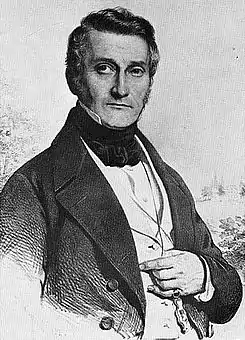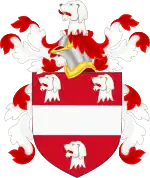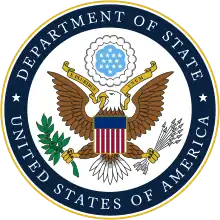Virgil Maxcy
Virgil Maxcy (May 5, 1785 – February 28, 1844) was an American political figure. He was born in Massachusetts and spent his adult years in Maryland. He was killed in 1844 in a shipboard accident, when a cannon exploded aboard USS Princeton.
Virgil Maxcy | |
|---|---|
 Lithograph of Virgil Maxcy, with Tulip Hill Estate in background | |
| 2nd United States Chargé d'Affaires to Belgium | |
| In office October 24, 1837 – September 17, 1842 | |
| President | Martin Van Buren |
| Preceded by | Hugh S. Legaré |
| Succeeded by | Henry Washington Hilliard |
| 1st Solicitor of the United States Treasury | |
| In office May 29, 1830 – June 15, 1837 | |
| President | Andrew Jackson |
| Preceded by | None |
| Succeeded by | Henry D. Gilpin |
| Maryland House of Delegates | |
| In office 1824–1825 | |
| Maryland Senate | |
| In office 1817–1821 | |
| Maryland Executive Council | |
| In office December 1815[1] – December, 1816[2] | |
| Preceded by | Alexander Contee Magruder William H. Ward Thomas G. Addison Samuel Ridout John Murray[4] |
| Succeeded by | William Potter Henry Henley Chapman Richard Frisby James Shaw William H. Ward[4] |
| Personal details | |
| Born | May 5, 1785 Attleboro, Massachusetts, U.S. |
| Died | February 28, 1844 (aged 58) (at sea near) Fort Washington, Maryland, U.S. |
| Spouse | Mary Galloway Maxcy |
| Alma mater | Brown University |
| Profession | Attorney Plantation owner |
Early life
The younger brother of Jonathan Maxcy, Virgil Maxcy was born in Attleboro, Massachusetts, on May 5, 1785.[5][6][7] He graduated from Brown University in 1804, studied law with Robert Goodloe Harper, was admitted to the bar in 1807, and became an attorney in Baltimore, Maryland.[8][9]
Author
In 1811 Maxcy authored The Laws of Maryland from 1692 to 1809, a multi-volume work that compiled Maryland's statutes, declaration of independence, constitution and amendments.[10]
Maxcy also prepared and distributed The Maryland resolutions, and the objections to them considered (1822), which argued against proposals to appropriate public land for the building of schools and other purposes.[11]
In 1833 he delivered A discourse before the Phi Beta Kappa Society of Brown University, a lecture that was published as a pamphlet.[12]
Political career
Originally a Federalist, Maxcy served on Maryland's Executive Council in 1815 and served terms in the Maryland Senate (1817–1821)[13] and the Maryland House of Delegates (1824–1825).[14][15][16]
Maxcy later became a Democrat and supported Andrew Jackson for President in 1824 and 1828. When Jackson won the 1828 election, Maxcy's friend John C. Calhoun attempted to have him appointed as Treasurer of the United States, but Jackson and Secretary of the Treasury Samuel D. Ingham decided for political reasons to offer the position to John Campbell.[17] Instead, Maxcy received appointment as Solicitor of the Treasury, where he served from 1830 to 1837.[18][19][20][21][22][23]
Maxcy was active in the American Colonization Society (ACS), and in 1837 was one of the incorporators who successfully petitioned to change the organization's name; it had previously been known as the Society for the Colonization of Free People of Color of America.[24]
Also in 1837, President Martin Van Buren named William Haywood as US Chargé d'Affaires in Belgium. Haywood declined the appointment, and Van Buren then named Maxcy, who served until 1842.[25][26][27]
In February 1844, Maxcy was considered for the position of Secretary of the Navy, but President Tyler appointed Thomas Walker Gilmer instead.[28] Gilmer was killed in the same accident that killed Maxcy.[29]
Death and burial
Maxcy died near Fort Washington, Maryland, on February 28, 1844, as a result of the explosion on board USS Princeton, which also killed five others, including two members of President John Tyler's cabinet. Maxcy was struck by metal shards from the "Peacemaker" cannon, a large artillery piece made by the Hogg & Delamater Ironworks which was being fired as part of a demonstration for visiting dignitaries. According to published accounts, Maxcy lost both arms and a leg in the explosion and was killed instantly.[30][31][32][33][34][35][36][37]
Maxcy was originally entombed at Congressional Cemetery in Washington, D.C.[38] He was later reinterred at Tulip Hill, a large estate near Annapolis, Maryland, that was owned by his wife's family.[39][40]
Personal life
Virgil Maxcy was married to Mary Galloway, a member of one of Maryland's most prominent plantation owning families. He was thus a wealthy man, with most of his fortune consisting of slaves and land.[41][42]
The children of Virgil and Mary Galloway Maxcy included Ann (1813–1891), Mary (1812–1878), Cornelia (1815–1823), and Juliana (1816–1818).
Ann Maxcy was the wife of George Wurtz Hughes, who served as a United States representative from Maryland.[43]
Mary Maxcy married Francis Markoe (1801–1872) in 1834. Their children included Francis Markoe (1840–1914), who married Maria Perry Thomas of Talbot County, Maryland and Emilie Maxcy Markoe (1852–1925), who married D. C. F. Rivinus.
Maxcy was a longtime friend of John C. Calhoun. They exchanged frequent letters, many of which have been published.[44][45][46]
Legacy

He was the subject of a biography, 1981's A Federalist Converted: The Life of Virgil Maxcy of Maryland, 1785-1844, by Michael Cullen Reis.[47]
Maxcy is a prominent figure in academic discussions about same-sex intimate relationships in the United States during the early 1800s, which results from a letter he sent to a friend. In the letter to William Blanding of Rehoboth, Massachusetts, Maxcy reminisces about sharing a bed with Blanding, including the line "Sometimes I think I have got hold of your doodle when in reality I have hold of the bedpost."[48][49][50]
References
- "Abstract of the Proceedings of the Legislature of Maryland: House of Delegates; Tuesday, December 12, P. M., half past 5 o'clock". Maryland Gazette. Annapolis, MD. December 21, 1815. p. 2.
- "The Senate: Tuesday, Dec. 10". Maryland Gazette. Annapolis, MD. January 9, 1817. p. 3.
- "Governors' Councils, 1777-1838". Archives of Maryland Historical List. Annapolis, MD: Maryland State Archives. Retrieved March 15, 2017.
- "Governors' Councils, 1777-1838".
- Edwin L. Green, A History of the University of South Carolina, 1915, page 321
- Eugene M. Wait, Adams vs. Jackson, 2001, page 92
- Jonathan Maxcy, The Literary Remains of the Rev. Jonathan Maxcy, 1844, page 29
- William Giles Goddard, The Political and Miscellaneous Writings of William G. Goddard, Volume 1, 1870, page 432
- American & Commercial Daily Advertiser (Baltimore), public notice of law office opening, James M. Brown and Virgil Maxcy, September 28, 1809
- The provincial councillors of Pennsylvania, by Charles Penrose Keith, 1883, p. 339
- The Maryland resolutions, and the objections to them considered, by Virgil Maxcy, 1822, title page
- A discourse before the Phi Beta Kappa Society of Brown University, by Virgil Maxcy, 1833, title page
- Virgil Maxcy entry, Archives of Maryland, Historical List, Maryland Senate Member Index, 1777-2000
- Virgil Maxcy entry, Archives of Maryland Historical List, House of Delegates, Anne Arundel County (1790–1974)
- Belgian-American diplomatic and consular relations 1830-1850, by John W. Rooney, 1969, Vol. 41, p. 84
- Aggressive Nationalism: McCulloch v. Maryland and the Foundation of Federal Authority in the Young Republic, by Richard E. Ellis, 2007, p. 69
- John C. Calhoun and the Price of Union: A Biography, by John Niven, 1993, p. 26
- Poore, Benjamin Perley (1878). The political register and congressional directory: a statistical record of the Federal Officials...1776-1878. Boston: Houghton, Osgood and Co. p. 230.
solicitors.
- Niles' Weekly Register, August 28, 1830, p. 13
- Who Was Who in America, published by Marquis Who's Who, 1963, p. 340
- Report From Virgil Maxcy, Solicitor of the Treasury, on the Case of Francis Cazeau's Representatives, published by U.S. Senate, 1836, title page
- The Political and Miscellaneous Writings of William G. Goddard, by William Giles Goddard, 1870, Vol. 1, p. 432
- The New York Annual Register, by Edwin Williams, 1833, p. 366
- Executive Committee (1841). 24th Annual Report. Vol. 19–32. American Colonization Society: Washington, DC. pp. 29–30.
- The Papers of Henry Clay, by Henry Clay, edited by Robert Seager II and Melba Porter Hay, 1988, Vol. 9, p. 39
- The literary remains of the Rev. Jonathan Maxcy, by Romeo Elton, 1844, p. 29
- Message from the President of the United States to the Two Houses of Congress at the Commencement of the First Session of the Twenty-Seventh Congress, published by US Dept. of State, 1841, p. 133
- Detroit Free Press, Mr. Spencer has resigned the office of Secretary of the U.S. Treasury, February 3, 1844
- James V. Marshall, The United States Manual of Biography and History, 1856, page 482
- Potter's American Monthly, published by John E. Potter & Co., Philadelphia, 1876, Vol. 6-7, p. 111
- The Rise of American Democracy: Jefferson to Lincoln, by Sean Wilentz, 2006, p. 566
- Congressional report: Accident on Steam-Ship "Princeton", US House of Representatives Committee on Naval Affairs, 1844, p. 1
- Newspaper article, AWFUL CALAMITY!, Baltimore Sun, February 29, 1844
- Newspaper article, Further Particulars, Baltimore Sun, March 1, 1844
- Newspaper article, Heart Rending and Fatal Calamity, originally printed in New York Journal of Commerce, republished in Hartford Times, March 9, 1844
- Newspaper article, Chronicle of Important Events During the Past Year, Baltimore Sun, January 3, 1845
- Magazine article, "The beauty and chivalry of the United States assembled …", by Donald B. Webster, Jr., American Heritage magazine, Vol. 17, Issue 1, December 1965
- Walters, Kerry (2013). Explosion on the Potomac: The 1844 Calamity Aboard the USS Princeton. Charleston, SC: History Press. p. Obsequies and Inquiries. ISBN 978-1-62584-665-5.
- This was Potomac River, by Frederick Tilp, 1987, p. 113
- Wild Rose: The True Story of a Civil War Spy, by Ann Blackman, 2006, p. 131
- Maryland Historical Magazine, published by Maryland Historical Society, 1965, Vol. 60, p. 383
- Maryland -- A History, 1632-1974, by Maryland Historical Society, 1974, p. 259
- The Leverett Letters: Correspondence of a South Carolina Family, 1851-1868, edited by Frances Wallace Taylor, Catherine Taylor Matthews and J. Tracy Power, 2000, page 481
- Correspondence of John C. Calhoun, by John Caldwell Calhoun, 1900, Vol. 2, Part 2, p. 791
- John C. Calhoun: American Portrait, Margaret L. Coit, 1950, p. 209
- Community Leadership in Maryland, 1790-1840, by Whitman H. Ridgway, 1979, p.e 345
- A Federalist Converted: The Life of Virgil Maxcy of Maryland, 1785-1844, by Michael Cullen Reis, published by George Washington University, title page
- Reis, Elizabeth (2012). American Sexual Histories. Malden, MA: John Wiley & Sons. p. 106. ISBN 978-1-4443-3929-1.
- Mintz, Steven (2015). The Prime of Life: A History of Modern Adulthood. Cambridge, MA: Belknap Press. p. 66. ISBN 978-0-674-04767-9.
- Godbeer, Richard (2009). The Overflowing of Friendship: Love between Men and the Creation of the American Republic. Baltimore, MD: Johns Hopkins University Press. pp. 57–58. ISBN 978-0-8018-9120-5.
doodle.
External links
- Find A Grave page, Virgil Maxcy, accessed April 2, 2011.
- Political Graveyard page, Virgil Maxcy, accessed April 2, 2011.
- Newspaper article, Living History: William and Patrice Chaney at Home in Maryland’s Past, by Margaret Tearman, Bay Weekly, Volume 15, Issue 29 ~ July 19–25, 2007
